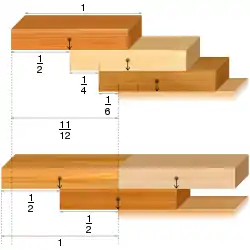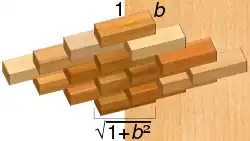Block-stacking problem
In statics, the block-stacking problem (sometimes known as The Leaning Tower of Lire (Johnson 1955), also the book-stacking problem, or a number of other similar terms) is a puzzle concerning the stacking of blocks at the edge of a table.

Statement
The block-stacking problem is the following puzzle:
Place identical rigid rectangular blocks in a stable stack on a table edge in such a way as to maximize the overhang.
Paterson et al. (2007) provide a long list of references on this problem going back to mechanics texts from the middle of the 19th century.
Variants
Single-wide
The single-wide problem involves having only one block at any given level. In the ideal case of perfectly rectangular blocks, the solution to the single-wide problem is that the maximum overhang is given by times the width of a block. This sum is one half of the corresponding partial sum of the harmonic series. Because the harmonic series diverges, the maximal overhang tends to infinity as increases, meaning that it is possible to achieve any arbitrarily large overhang, with sufficient blocks.
| N | Maximum overhang | |||
|---|---|---|---|---|
| expressed as a fraction | decimal | relative size | ||
| 1 | 1 | /2 | 0.5 | |
| 2 | 3 | /4 | 0.75 | |
| 3 | 11 | /12 | ~0.91667 | |
| 4 | 25 | /24 | ~1.04167 | |
| 5 | 137 | /120 | ~1.14167 | |
| 6 | 49 | /40 | 1.225 | |
| 7 | 363 | /280 | ~1.29643 | |
| 8 | 761 | /560 | ~1.35893 | |
| 9 | 7 129 | /5 040 | ~1.41448 | |
| 10 | 7 381 | /5 040 | ~1.46448 | |
| N | Maximum overhang | |||
|---|---|---|---|---|
| expressed as a fraction | decimal | relative size | ||
| 11 | 83 711 | /55 440 | ~1.50994 | |
| 12 | 86 021 | /55 440 | ~1.55161 | |
| 13 | 1 145 993 | /720 720 | ~1.59007 | |
| 14 | 1 171 733 | /720 720 | ~1.62578 | |
| 15 | 1 195 757 | /720 720 | ~1.65911 | |
| 16 | 2 436 559 | /1 441 440 | ~1.69036 | |
| 17 | 42 142 223 | /24 504 480 | ~1.71978 | |
| 18 | 14 274 301 | /8 168 160 | ~1.74755 | |
| 19 | 275 295 799 | /155 195 040 | ~1.77387 | |
| 20 | 55 835 135 | /31 039 008 | ~1.79887 | |
| N | Maximum overhang | |||
|---|---|---|---|---|
| expressed as a fraction | decimal | relative size | ||
| 21 | 18 858 053 | /10 346 336 | ~1.82268 | |
| 22 | 19 093 197 | /10 346 336 | ~1.84541 | |
| 23 | 444 316 699 | /237 965 728 | ~1.86715 | |
| 24 | 1 347 822 955 | /713 897 184 | ~1.88798 | |
| 25 | 34 052 522 467 | /17 847 429 600 | ~1.90798 | |
| 26 | 34 395 742 267 | /17 847 429 600 | ~1.92721 | |
| 27 | 312 536 252 003 | /160 626 866 400 | ~1.94573 | |
| 28 | 315 404 588 903 | /160 626 866 400 | ~1.96359 | |
| 29 | 9 227 046 511 387 | /4 658 179 125 600 | ~1.98083 | |
| 30 | 9 304 682 830 147 | /4 658 179 125 600 | ~1.99749 | |
The number of blocks required to reach at least block-lengths past the edge of the table is 4, 31, 227, 1674, 12367, 91380, ... (sequence A014537 in the OEIS).[1]
Multi-wide

Multi-wide stacks using counterbalancing can give larger overhangs than a single width stack. Even for three blocks, stacking two counterbalanced blocks on top of another block can give an overhang of 1, while the overhang in the simple ideal case is at most 11/12. As Paterson et al. (2007) showed, asymptotically, the maximum overhang that can be achieved by multi-wide stacks is proportional to the cube root of the number of blocks, in contrast to the single-wide case in which the overhang is proportional to the logarithm of the number of blocks. However, it has been shown that in reality this is impossible and the number of blocks that we can move to the right, due to block stress, is not more than a specified number. For example, for a special brick with h = 0.20 m, Young's modulus E = 3000 MPa and density ρ = 1.8×103 kg/m3 and limiting compressive stress 3 MPa,the approximate value of N will be 853 and the maximum tower height becomes 170 m.[2]

Robustness
Hall (2005) discusses this problem, shows that it is robust to nonidealizations such as rounded block corners and finite precision of block placing, and introduces several variants including nonzero friction forces between adjacent blocks.
References in media
In 2018, Michael Stevens, creator of various YouTube channels including Vsauce and D!NG, uploaded a video where Michael and former MythBusters star Adam Savage, discuss and construct a model of the block-stacking problem using plywood.[4]
References
- Sloane, N. J. A. (ed.). "Sequence A014537 (Number of books required for n book-lengths of overhang in the harmonic book stacking problem.)". The On-Line Encyclopedia of Integer Sequences. OEIS Foundation.
- Khoshbin-e-Khoshnazar, M. R. (2007). "Simplifying modelling can mislead students". Physics Education. 42: 14–15. doi:10.1088/0031-9120/42/1/F05. S2CID 250745206.
- M Paterson et al, Maximum Overhang, The Mathematical Association of America, November 2009
- The Leaning Tower of Lire, retrieved 2022-08-02
- Hall, J. F. (2005). "Fun with stacking blocks". American Journal of Physics. 73 (12): 1107–1116. Bibcode:2005AmJPh..73.1107H. doi:10.1119/1.2074007..
- Johnson, Paul B. (April 1955). "Leaning Tower of Lire". American Journal of Physics. 23 (4): 240. Bibcode:1955AmJPh..23..240J. doi:10.1119/1.1933957.
- Paterson, Mike; Peres, Yuval; Thorup, Mikkel; Winkler, Peter; Zwick, Uri (2007). "Maximum overhang". arXiv:0707.0093 [math.HO].
External links
- Weisstein, Eric W. "Book Stacking Problem". MathWorld.
- "Building an Infinite Bridge". PBS Infinite Series. 2017-05-04. Retrieved 2018-09-03.